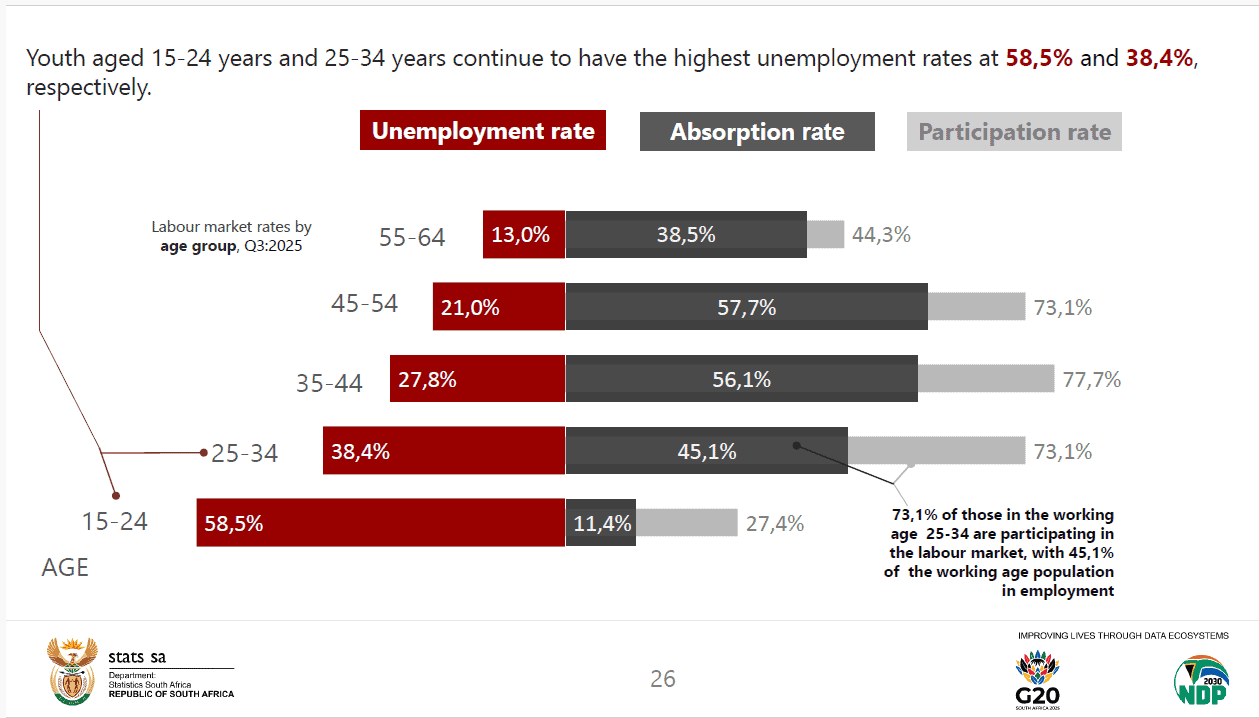
Unemployment decreased by 1.3% in the third quarter of 2025, from 33.2% in the second quarter to 31.9% in the third quarter.
According to Statistics SA’s Quarterly Labour Force Survey for the third quarter, there was an increase of 248 000 in the number of employed people to 17.1 million and a decrease of 360 000 in the number of unemployed people to 8 million.
During the third quarter discouraged jobseekers increased by 36 000 to 3.5 million, while the number of other available jobseekers increased by 130 000 to 965 000 and unavailable jobseekers increased by 64 000 to 83 000.
This resulted in a total net increase of 230 000 to 4.5 million in the potential labour force population (people who were available, but not seeking or unavailable but seeking). Other people outside the labour force (previously called “Other not economically active population) increased by 8 000 to 12.4 million.
ALSO READ: World Bank says this is how South Africa can create more jobs
Unemployment among people outside the labour force
Outside the labour force, which is the total of the potential labour force and other outside the labour force, increased by 239 000 to 16.9 million in the third quarter.
Statistics SA says in addition to the unemployment rate, other measures of labour underutilisation have been recommended. The combined rate of unemployment and time-related underemployment decreased by 1.2 percentage points to 34,9%, while the combined rate of unemployment and potential labour force decreased by 0.6 of a percentage point to 42.4% in the third quarter compared to the second quarter of 2025.
The composite measure of labour underutilisation (which combines time-related underemployment, unemployment and potential labour force as a proportion of extended labour force) was 44.9% in the third quarter of 2025.
Statistics SA says these labour underutilisation measures highlight people in different situations and with different degrees of attachment to the labour market.
ALSO READ: SA continues to bleed jobs as employment shrinks for second time
These sectors made the most progress to reduce unemployment
Total employment increased by 248 000 quarter-on-quarter, with the largest increases recorded in construction (130 000), community and social services (116 000) and trade (108 000). The largest decreases in employment were observed in manufacturing (62 000), finance (54 000) and utilities (30 000).
Statistics SA points out that the definitions of the formal/informal sector and formal/informal employment changed significantly based on the latest international resolution and as a result, the third quarter estimates on informality cannot be compared with the previous estimates.
The formal sector employed 12 million people, the informal sector 4 million and the household sector 1.1 million people.
ALSO READ: Unemployment could get even worse in third quarter due to US tariffs
Only one province did not create more jobs, with unemployment increasing
According to the survey, the number of employed people increased in eight provinces in the third quarter. The largest employment gains were recorded in the Western Cape, with 70 000 new jobs, KwaZulu-Natal with 54 000, Gauteng with 51 000, North West with 42 000 and Limpopo 40 000).
Unfortunately, a decrease in employment was recorded in the Eastern Cape, where 53 000 jobs were shed.
The unemployment rate among the black African (35.8%) population group remains higher than the national average and other population groups. The unemployment rate for white people is 8.1%, for Asian and Indian people 13.9% and for coloured people 22.1%.
The graduate unemployment rate decreased by 1.8 percentage points from 12.2 in the second quarter to 10.4 in the third quarter. People with matric remain vulnerable with an unemployment rate of 34% and 38% for people with less than matric.
The unemployment picture for young people remains dire as this graph shows:




